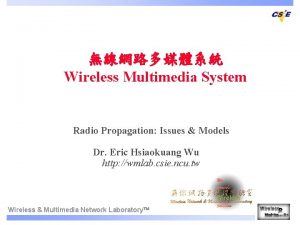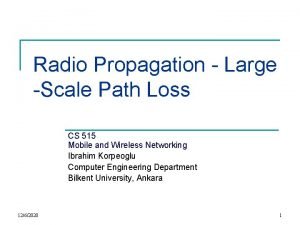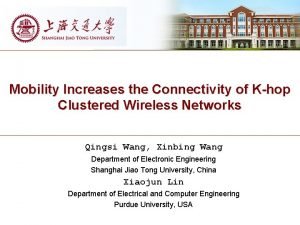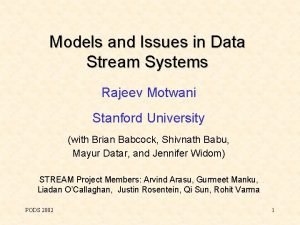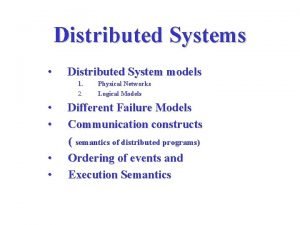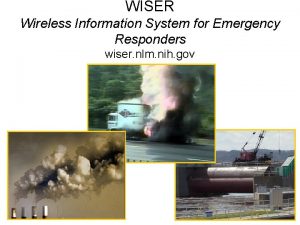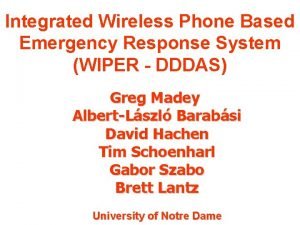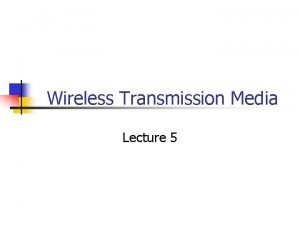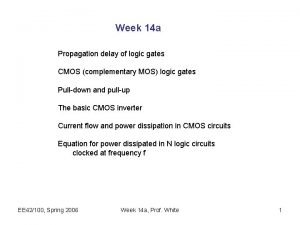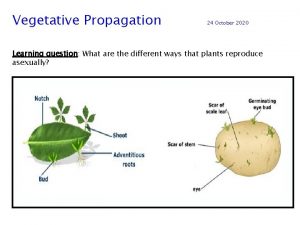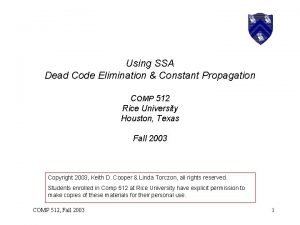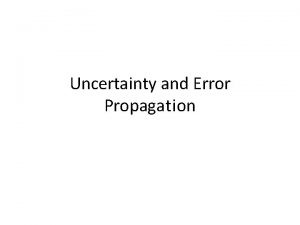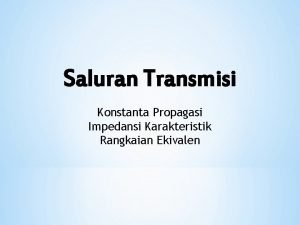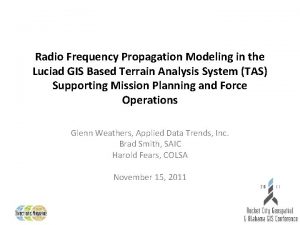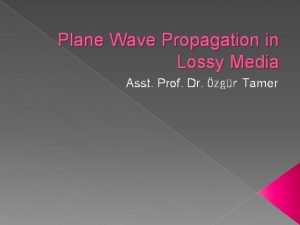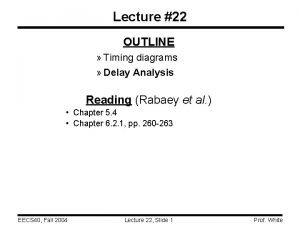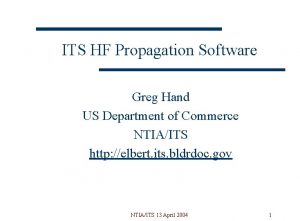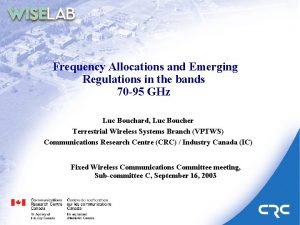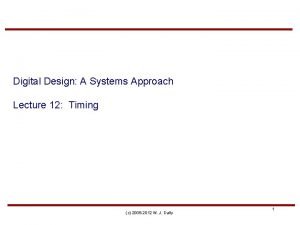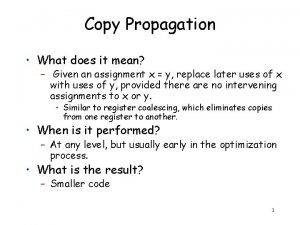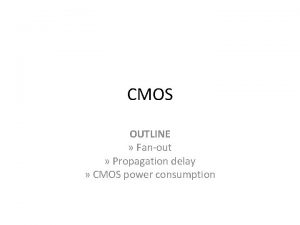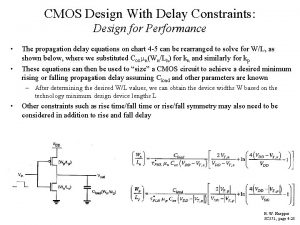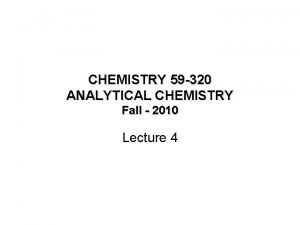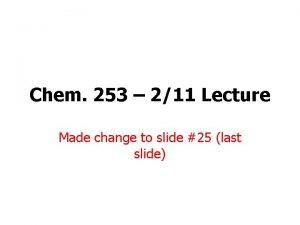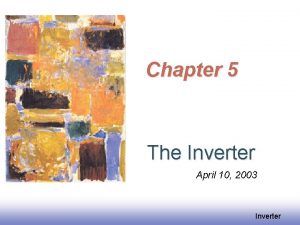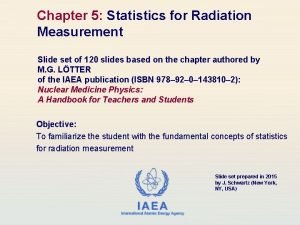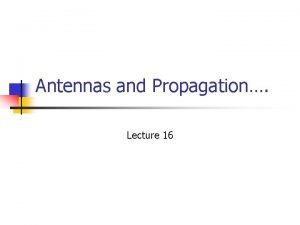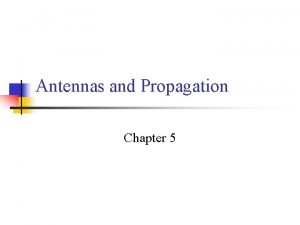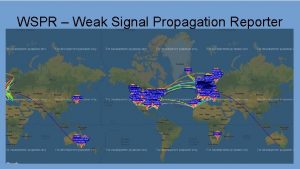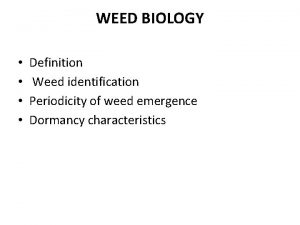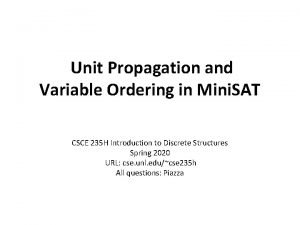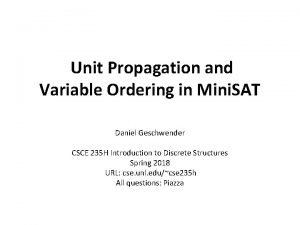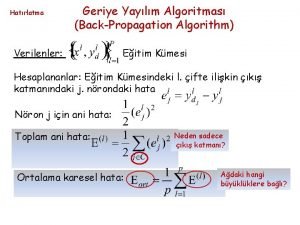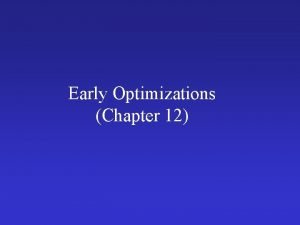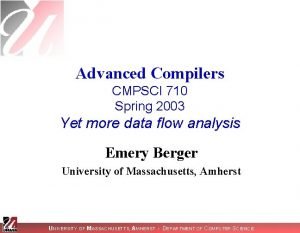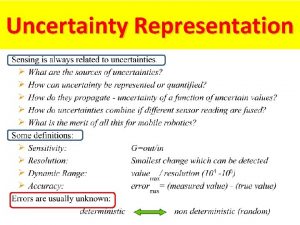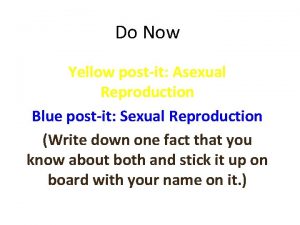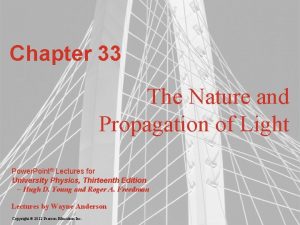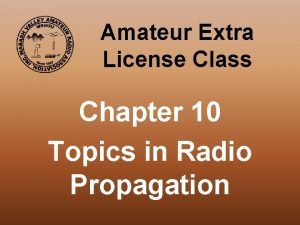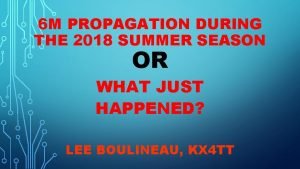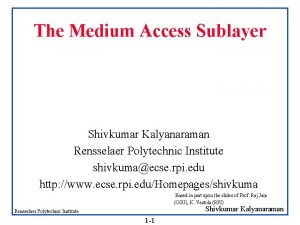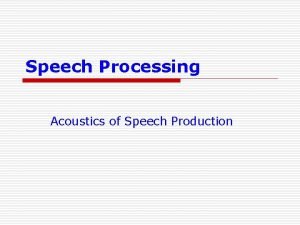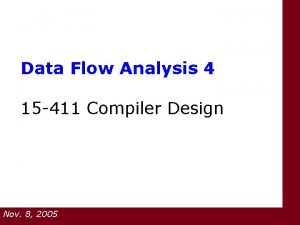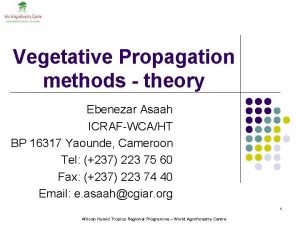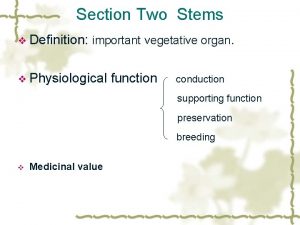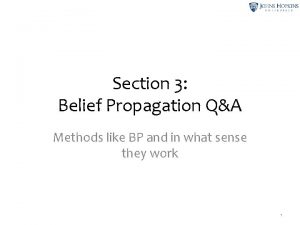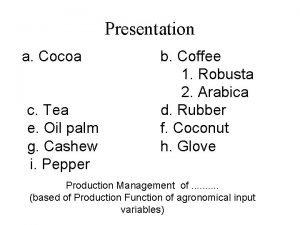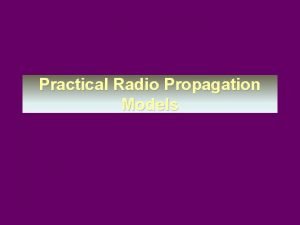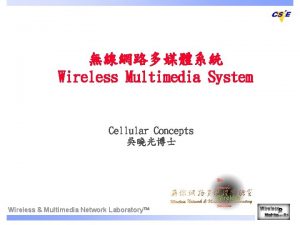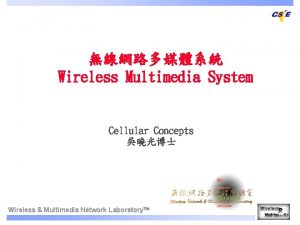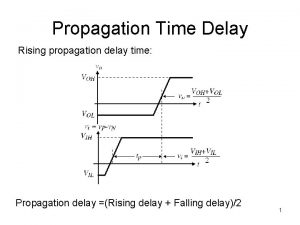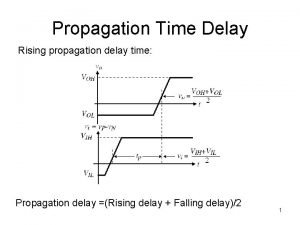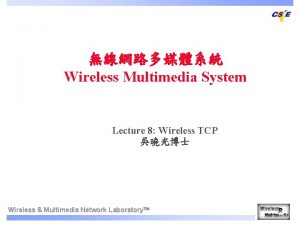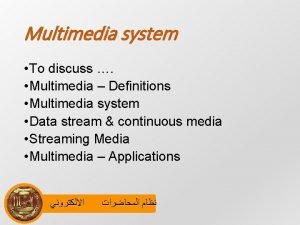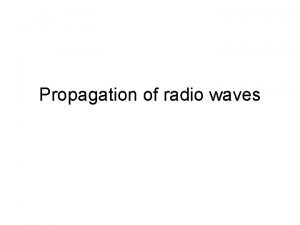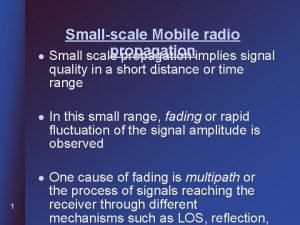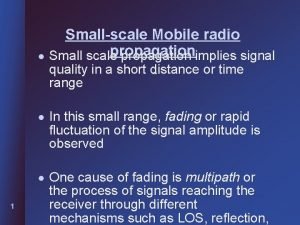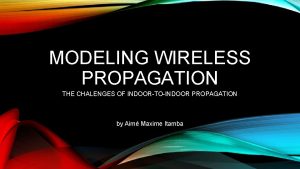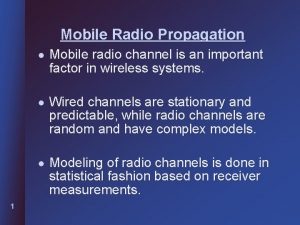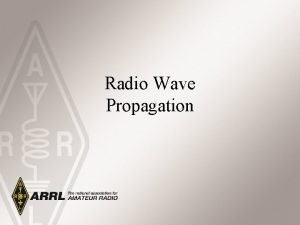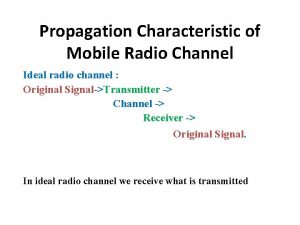Wireless Multimedia System Radio Propagation Issues Models Dr






















































































- Slides: 86

無線網路多媒體系統 Wireless Multimedia System Radio Propagation: Issues & Models Dr. Eric Hsiaokuang Wu http: //wmlab. csie. ncu. tw Wireless & Multimedia Network Laboratory

Lecture II Agenda w Radio Propagation • • • Physical of radio propagation Two types of propagation models Outdoor vs. Indoor Radio Propagation Model How to do simple “ link budget” calculation Combating the radio channel impairment w Wireless Modem Design w Modern Application: 911 services Wireless & Multimedia Network Laboratory

Path Loss Model (Large Scale) Telco Core Network or Private (Fiber) Network d Wireless & Multimedia Network Laboratory d 0 INTERNET BACKBONE

Multi-path fading (Small Scale) Telco Core Network or Private (Fiber) Network INTERNET BACKBONE Wireless & Multimedia Network Laboratory

Reading list for This Lecture w Required Reading: (Jorgen 95) J. B. Andersen, T. S. Rappaport, “Propagation Measurements and Models for Wireless Communications channels”, (IEEE Communication Magazine), pp. 42~49 (Jeffrey H 98) Jeffrey H. Reed, Kevin J. Krizman, Brian D. Woerner, and T. S. Rappaport, “An Overview of the Challenges and Progress in Meeting the E-911 Requirement for Location Service, (IEEE Communication Magazine), pp. 30~37 Further Reading (Rappaport 97) T. S. Rappaport, K. Blankenship, H. Xu, “Propagation and Radio System Design Issues in Mobile Radio Systems for the Glo. Mo Project Wireless & Multimedia Network Laboratory

The mystery of the Radio Propagation Wireless & Multimedia Network Laboratory

How to deal with Radio Propagation IP backbone Wireless & Multimedia Network Laboratory

Where are you from? Wireless & Multimedia Network Laboratory

Qo. S and Multimedia Traffic Support Application OS, Middle. Ware RTP, TCP, UDP Adaptive Algorithm by Qo. S Requirement RSVP IP, Mobile IP Wireless Network Layer Clustering(optional) Data Link MAC Radio Wireless & Multimedia Network Laboratory Mobility Unpredictable channel by Qo. S Information

Simplified View of a Digital Radio Link Source Coder Multiplex Source Coder Multiple Access Channel Coder Modulator Power Amplifier Carrier fc Radio Channel “Limited b/w” “Highly variable b/w” “Random & Noisy” “Spurious Disconnections” Source Coder Demultiplex Multiple Access Channel Decoder Demodulator & Equalizer Carrier fc Wireless & Multimedia Network Laboratory RF Filter

Digital to Analog Modulation Wireless & Multimedia Network Laboratory

Digital-Analog Modulation Wireless & Multimedia Network Laboratory

Digital Correlator Wireless & Multimedia Network Laboratory

Multiple correlators w Multiple correlators in each receiver w At any instant of time, the signal carriers in the different correlators are synchronize to signal paths with different propagation times w A search circuit examines the arriving signal in order to detect the appearance of a new path, then assign a correlator to synchronize the signal on the path Wireless & Multimedia Network Laboratory

Key role for the radio propagation w Radio Propagation determines • • • the area which could be covered The maximum data rate in a system Battery power requirement for mobile transceivers Wireless & Multimedia Network Laboratory

Wireless & Multimedia Network Laboratory

Wireless & Multimedia Network Laboratory

Wireless & Multimedia Network Laboratory

Radio Channel w Free Space w Land Mobile w Multi-path Propagation w Shadow Wireless & Multimedia Network Laboratory

Some Distributions w Normal (Gaussian) w Log-normal Distribution w Rayleigh Distribution w Rician Distribution • Dominant path w Impulse Response Wireless & Multimedia Network Laboratory

Propagation Mechanisms in Space with Objects w Reflection (with Transmittance and Absorption) • • Radio wave impinges on an object Surface of earth, walls, buildings, atmospheric layers If perfect (lossless) dielectric object, then zero absorption If perfect conductor, then 100%reflection w Diffraction • Radio path is obstructed by an impenetrable surface with sharp irregularities (edges) • • • Secondary waves “bend” around the obstacle (Huygen’s principle) Explain how RF energy can travel without LOS “shadowing w Scattering (diffusion) • Similar principles as diffraction, energy reradiated in many directions Wireless & Multimedia Network Laboratory

Reflection, Diffraction, and Scattering in Real-Life w Received signal often a sum of contributions from different directions w Random phases make the sum behave as noise (Rayleigh Fading) Wireless & Multimedia Network Laboratory

Small-scale and Large-scale Fading w Signal fades rapidly as receiver moves, but the local average signal changes much more slowly Wireless & Multimedia Network Laboratory

Wireless & Multimedia Network Laboratory

Wireless & Multimedia Network Laboratory

Wireless & Multimedia Network Laboratory

Wireless & Multimedia Network Laboratory

Wireless & Multimedia Network Laboratory

Wireless & Multimedia Network Laboratory

Wireless & Multimedia Network Laboratory

Analysis of the Propagation w Large Scale Effect • The variation of the mean received signal strength over large distance or long time intervals w Small Scale Effect • The fluctuations of the received signal strength about a local mean, where these fluctuations occur over small distances or short time interval Wireless & Multimedia Network Laboratory

Large Scale -> Link Budget Wireless & Multimedia Network Laboratory

Wireless & Multimedia Network Laboratory

Wireless & Multimedia Network Laboratory

Free Space Propagation Model w Used when Transmitter and Receiver have a clear, unobstructed, line of sight (LOS) path • e. g. satellite channels, microwave LOS radio links w Free space power at a receiver antenna at a distance d from transmitter antenna is where, Gt and Gr are antenna gains L >= 1 is the system loss factor not related to propagation (e. g. loss due to filter losses, hardware w Path loss = signal attenuation as a positive quantity in d. B Wireless & Multimedia Network Laboratory

Wireless & Multimedia Network Laboratory

Example: Ground Reflection (2 -Ray) T Model ELOS ht R Ei qi qr Er d hr w Model found a good predictor for large-scale signal strength over distances of several kilometers for mobile systems with tall towers (heights > 50 m) as well as for LOS microcell channels w Can show (physics) that for large d w Much more rapid path loss than expected due to free spaces Wireless & Multimedia Network Laboratory

Log-Distance Path Loss Model w Assume average power (in d. B) decreases proportional to log of distance w Justification? • • Measurements Intuition/theory. . Recall; free space, ground-reflection model w Problem: “Environment Clutter” may differ at two locations at the same time (Log-normal Shadowing) Wireless & Multimedia Network Laboratory

Typical Path Loss Exponent, n Environment Path Loss Exponent, n Free Space 2 Urban area cellular / PCS 2. 7 to 4. 0 Shadow urban cellular / PCS 3 to 5 In building line of sight 1. 6 to 1. 8 Obstructed in building 4 to 6 Obstructed in factories 2 to 3 Wireless & Multimedia Network Laboratory

Practical Link Budget Design Using Path Loss Models w Bit-Error-rate is a function of SNR (signal-to-noise ratio), or equivalently CIR (carrier-to-interference ratio), at the receiver • The “function” itself depends on the modulation scheme w Link budget calculations allow one to compute SCR or CIR w Battery Life-> Talk Time -> received/Transmitted power -> Path Loss Models Wireless & Multimedia Network Laboratory

Example Link Budget Calculation w Maximum separation distance vs. transmitted power (with fixed BW) • Given s s • • Cellular phone with 0. 6 W transmitted power Unity gain antenna, 900 MHz carrier frequency SNR must be at least 25 d. B for proper reception Receiver BW is B=30 KHz, noise figure F=10 d. B What will be the maximum distance? Solution: s s N= -174 d. Bm + 10 log 30000 + 10 d. B For SNR > 25 d. B, we must have Pr > (-119+25) = -94 d. Bm Pt=0. 6 W = 27. 78 d. Bm This allows path loss PL(d) = Pt – Pr < 122 d. B for free space, n=2, d < 33. 5 km for shadowed urban with n=4, d < 5. 8 km Wireless & Multimedia Network Laboratory

Link Budget (SNR) w w w Frequency Power Distance Environments Bandwidth Wireless & Multimedia Network Laboratory

Noise w w N=KT 0 BF (K=1. 38*10 -23 J/K Boltzmann’s constant, T 0=290 K) N(d. Bm)=174(d. Bm)+10 log 10 B+F(d. B) Wireless & Multimedia Network Laboratory

Distance/Power/Battery/Environment Wireless & Multimedia Network Laboratory

BW/Power/Battery/Environment Wireless & Multimedia Network Laboratory

Effectiveness of RTS/CTS handshake in 802. 11 Ad hoc Network Wireless & Multimedia Network Laboratory

Large Area Interference Problem Wireless & Multimedia Network Laboratory

RMS Delay Spreads Wireless & Multimedia Network Laboratory

Small Scale -> Quality of Service Wireless & Multimedia Network Laboratory

Small-Scale Fading Effects (over small t and x) w Fading manifests itself in three ways • • • Time dispersion caused by different delays limits transmission rates Rapid changes in signal strength over small x or t Random frequency modulation due to varying Doppler shifts w In urban areas, mobile antenna heights << height of buildings • Usually no LOS from base station w Moving surrounding objects also cause time-varing fading Wireless & Multimedia Network Laboratory

Factors Influencing Small-Scale Fading w Multi-path propagation w Speed of Mobile w Speed of surrounding objects w Transmission bandwidth of the signal Wireless & Multimedia Network Laboratory

Wireless & Multimedia Network Laboratory

Wireless & Multimedia Network Laboratory

Wireless & Multimedia Network Laboratory

Delay Spread Wireless & Multimedia Network Laboratory

Wireless & Multimedia Network Laboratory

Wireless & Multimedia Network Laboratory

Wireless & Multimedia Network Laboratory

Wireless & Multimedia Network Laboratory

Wireless & Multimedia Network Laboratory

Parameters of a Multipath Channel w Multipath Channel Impulse Response (measured by sounding technique) w Four important parameters of interest • RMS delay spread • Coherence bandwidth • Doppler spread • Coherence time Wireless & Multimedia Network Laboratory

Wireless & Multimedia Network Laboratory

Types of Fading w Two independent mechanisms: • Time Dispersion (Due to Multi-path delays) s s • Flat fading Frequency Selective Fading Doppler Spread (due to Motion of mobile or channel) s s Fast Fading Slow Fading Wireless & Multimedia Network Laboratory

Fades: Why do we care? w Data Rate w Equalization w Fades result in “Error Bursts” w Average duration of (Flat) fades w Depends primarily on speed of the mobile. Wireless & Multimedia Network Laboratory

The Design of Wireless Modem Wireless & Multimedia Network Laboratory

Combating Errors w Increase transmitted power w (Adaptive) Equalization w Antenna or space diversity for “Multipath” w Forward error correction w Automatic Repeat Request (ARQ) Wireless & Multimedia Network Laboratory

Direct Sequence Spread Spectrum To transmit a 0 the station use a unique “chip sequence”: 10110 To transmit a 1 the station use the one’s complement of its chip sequence: 01001 Therefore if data is 1010 it will transmit: 1 0 1 Wireless & Multimedia Network Laboratory 0

w Transmitted signal is spread over a wide range of frequencies. (i. e. 2. 4002. 485 GHz) w Transmission usually hop 35 times per second. Frequency Hopping Spread Spectrum f 7 f 6 f 5 f 4 f 3 f 2 f 1 Time Wireless & Multimedia Network Laboratory

Antenna Types w n Omni Directional Antenna Wireless & Multimedia Network Laboratory YAGI Directional Antenna

Modern Applications: 911 Service Location Service Wireless & Multimedia Network Laboratory

E-911 Requirement for Location Service w 1996, FCC (Federal Communications Commission) announced its mandate for enhanced emergency services for cellular phone callers. w The current deadline for this capability is October 1, 2001 Wireless & Multimedia Network Laboratory

Wireless & Multimedia Network Laboratory

Wireless & Multimedia Network Laboratory


Wireless & Multimedia Network Laboratory

Introduction w Safety is the primary motivation for vehicle position location. w Landline telephone companies to provide 911 emergency service. w 1994, begin investigating similar service for U. S cellular and PCS providers. w E-911 service include caller’s ANI and street address information. Wireless & Multimedia Network Laboratory

Mobile Location Solution Driving Force : Legal aspects : • Fire brigades, hospitals and other emergency centers. Commercial aspects : • Differentiation : new and attractive services. • Reduced costs : operators can adapt their network to match calling patterns. • Increased revenues : commercial services that use positioning information is infinite. Wireless & Multimedia Network Laboratory

Positioning mechanism and requirement Terminal-based : • Positioning intelligence is stored in the terminal or its SIM card. • Network-assisted global positioning system (A-GPS). Network-based : • Positioning intelligence isn’t built into the handset. • Measurement of Cell global identity and timing advance(CGI+TA)、uplink time of arrival (UL-TOA). Wireless & Multimedia Network Laboratory

Mobile location solution has been designed to handle a variety of positioning methods and application interfaces. Wireless & Multimedia Network Laboratory

Network-assisted GPS (A-GPS) is a positioning product with very attractive characteristics. Wireless & Multimedia Network Laboratory

UL-TOA and E-OTD methods each use the triangulation of time difference between base stations and the terminal to determine positions. Wireless & Multimedia Network Laboratory

Location applications Information services : • Location-based yellow pages, events, and attractions (ex. What is happening today in town near here? ). Tracing services : • Tracing of a stolen car, helping paramedics to locate persons quickly in an emergency situation, and giving a towing service or automobile repair shop the location of a motorist in need (out of gas, flat tire, dead battery). Wireless & Multimedia Network Laboratory

Location applications (cont. ) Resource management : • Taxi fleet management, the administration of container goods, and the assignment and grouping of railway repairmen. Navigation : • Vehicle or pedestrian navigation. Wireless & Multimedia Network Laboratory

Small Scale Fading w Mean Excess Delay, rms delay spread 0 d. B -10 d. B -20 d. B -30 d. B 0 1 Wireless & Multimedia Network Laboratory 2 5 Ι (μs)

The chest of drawers illustrates how different applications can be grouped strategically for use by their beneficiaries. Wireless & Multimedia Network Laboratory

Channel Propagation and Fading Wireless & Multimedia Network Laboratory
 Free space propagation model in wireless communication
Free space propagation model in wireless communication Free space propagation model in wireless communication
Free space propagation model in wireless communication Free space propagation model in wireless communication
Free space propagation model in wireless communication Telecommunications, the internet, and wireless technology
Telecommunications, the internet, and wireless technology Awin radio
Awin radio Designer multimedia authoring system
Designer multimedia authoring system Models and issues in data stream systems
Models and issues in data stream systems Multimedia becomes interactive multimedia when
Multimedia becomes interactive multimedia when Definition of multimedia
Definition of multimedia Csc253 interactive multimedia
Csc253 interactive multimedia Esa multimedia.esa.int./multimedia/virtual-tour-iss
Esa multimedia.esa.int./multimedia/virtual-tour-iss Shall will difference
Shall will difference Message passing system in distributed system
Message passing system in distributed system Wireless geolocation system
Wireless geolocation system Distributed power wireless control system
Distributed power wireless control system Wireless intrusion prevention system
Wireless intrusion prevention system Wireless information system for emergency responders
Wireless information system for emergency responders Wireless response system
Wireless response system Line of sight propagation
Line of sight propagation How to calculate propagation delay in logic gates
How to calculate propagation delay in logic gates Vegetative propagation mind map
Vegetative propagation mind map Sparse conditional constant propagation
Sparse conditional constant propagation Optical fiber light propagation
Optical fiber light propagation Uncertainty propagation
Uncertainty propagation Accuracy and precision
Accuracy and precision Sparse conditional constant propagation
Sparse conditional constant propagation Rumus impedansi karakteristik
Rumus impedansi karakteristik Rf propagation modeling software
Rf propagation modeling software The attenuation constant in lossless dielectrics will be
The attenuation constant in lossless dielectrics will be Ch3 cl2
Ch3 cl2 Ethene hbr
Ethene hbr Propagation delay timing diagram
Propagation delay timing diagram Uncertainty propagation formula
Uncertainty propagation formula Its hf propagation
Its hf propagation Long path propagation
Long path propagation Rf propagation
Rf propagation Relative uncertainty
Relative uncertainty Propagation delay
Propagation delay Forward propogation
Forward propogation What is copy propagation
What is copy propagation Cmos power consumption
Cmos power consumption Propagation delay formula
Propagation delay formula Error propagation quotient
Error propagation quotient Propagation chemistry
Propagation chemistry Long path propagation
Long path propagation Propagation delay formula
Propagation delay formula Error propagation quotient
Error propagation quotient Bias in ann
Bias in ann Forward propagation
Forward propagation Line of sight propagation
Line of sight propagation Antennas and propagation
Antennas and propagation Wspr software
Wspr software Disadvantages of vegetative propagation
Disadvantages of vegetative propagation Unit propagation example
Unit propagation example Unit propagation example
Unit propagation example Banana is commercially propagated by
Banana is commercially propagated by Asexual propagation layering
Asexual propagation layering Backpropagation nedir
Backpropagation nedir Scalar replacement of aggregates
Scalar replacement of aggregates Phenolic foam
Phenolic foam Advantages of vegetative propagation
Advantages of vegetative propagation Vegetative propagation by stem can be seen in
Vegetative propagation by stem can be seen in Sparse conditional constant propagation
Sparse conditional constant propagation Trench layering
Trench layering Gaussian standard deviation
Gaussian standard deviation Benefits of sexual propagation
Benefits of sexual propagation Nature and propagation of light
Nature and propagation of light Chordal hop propagation
Chordal hop propagation 6m propagation
6m propagation Ethertype 88b5
Ethertype 88b5 Dahlia asexual reproduction
Dahlia asexual reproduction One way propagation delay
One way propagation delay Sound propagation
Sound propagation How the uniform offspring of your creature
How the uniform offspring of your creature Constant propagation in compiler design
Constant propagation in compiler design Dtl inverter
Dtl inverter Vegetative propagation
Vegetative propagation Simple layering examples
Simple layering examples Early wood and late wood difference
Early wood and late wood difference Loopy belief propagation
Loopy belief propagation Advantages of plant propagation
Advantages of plant propagation Vegetative propagation of tea
Vegetative propagation of tea Absolute refractory period and relative refractory period
Absolute refractory period and relative refractory period Disadvantages of smokeless chulha
Disadvantages of smokeless chulha Sexual propagation
Sexual propagation Specialized structure
Specialized structure Stem cuttings definition
Stem cuttings definition
